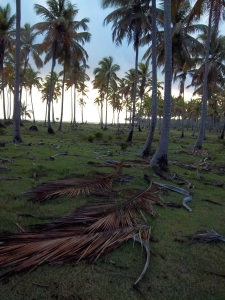By Liliana Usvat
The countries with more forests are more peaceful that one with large deforested areas.Is there a correlation between the percentage that a country is forested and the human society?
One of the records from England shows that deforestation during king Charles I in 1629 created considerable social unrest and riots.
In present times a sample of two neighboring countries that treat nature and forests differently are Dominican Republic and Haiti. They both reside on the same island and is half of the island is forested and half without forest. Dominican Republic is a major tourist destination so the economy and life of people is benefiting from tourism while Haiti is a country very much avoided by tourists. Is the respect for nature a factor?
What if we consider Canada and Middle East? Is the amount of forest and the influence of the forest on human consciousness a factor in the attitude of the people?
What about South America? Is there a connection between the destruction of the forest and the social unrest in these countries? The questions is what is the cause and what is the effect? Social unrest and poverty create logging and the destruction of the forest has an impact on the society at large or the other way around.
The destruction of the forest has an impact on the society in general and the degradation oflife in general.
- What is the solution?
- Does the industrial destruction of the forest has anything to do with the ownership of the land?
- Why does it matter? Because deforestation in one country affects us all. The ozon layer and the quality of the air we bread has no boundaries.
Forests and Human Emotions
Shinrin-yoku (walking and/or staying in forests in order to promote health) is a major form of relaxation in Japan
Forest environments are advantageous with respect to human emotions, especially among those experiencing chronic stress. Accordingly, shinrin-yoku may be employed as a stress reduction method, and forest environments can be viewed as therapeutic landscapes.
Therefore, customary shinrin-yoku may help to decrease the risk of psychosocial stress-related diseases, and evaluation of the long-term effects of shinrin-yoku is warante.
Forest bathing trip, called “Shinrinyoku”
In Japan, a forest bathing trip, called “Shinrinyoku” in Japanese, is a short, leisurely visit to a forest; it is regarded as being similar to natural aromatherapy.
This review focuses on the effects of forest bathing trips on human immune function. Beginning in 2005, adult Japanese individuals, both male and female, participated in a series of studies aimed at investigating the effect of forest bathing trips on human immune function.
The subjects experienced a 3-day/2-night trip to forest areas, and blood and urine were sampled on days 2 (the first sampling during each trip) and 3 (the second sampling during each trip), and on days 7 and 30 after the trips. Natural killer (NK) activity, the numbers of NK, granulysin-, perforin-, and granzymes A/B-expressing lymphocytes in the blood, and the concentration of urinary adrenaline were measured.
The same measurements were made before the trips on a normal working day as a control.
The increased NK activity lasted for more than 30 days after the trip, suggesting that a forest bathing trip once a month would enable individuals to maintain a higher level of NK activity.
In contrast, a visit to the city as a tourist did not increase NK activity, the numbers of NK cells, or the level of intracellular granulysin, perforin, and granzymes A/B.
These findings indicate that forest bathing trips resulted in an increase in NK activity, which was mediated by increases in the number of NK cells and the levels of intracellular granulysin, perforin, and granzymes A/B.
Forest visits enhance physiological and psychological health
Incidences of poor health have increased in urbanized societies, partly due to expanding urbanization and modern lifestyles that are related to increasing sedentary work and mental stress. Growing stress is connected with urban living and contemporary work practices dominated by high technology and virtual worlds . It seems that current health care practices alone cannot solve these problems. Recently, the potential of natural and green spaces in enhancing human health has been recognized
Forest environments promote humans’ mental and physical health in many ways:
- forests help in reducing stress and in recovering from attentional fatigue,
- and generally forests strongly enhance both psychological and physical rehabilitation. Research on the restorative influences of nature has been dominated by two theories, one emphasizing stress reduction and the other focusing on the recovery of the capacity to focus attention .
- Forests may assist both in preventing illnesses that are mediated by psychological processes such as stress and in
- curing diseases such as burn-out and depression.
- Green areas can also help in establishing personal and community identity,
- social activity, and
- social participation .
Health Benefits From Forests
Numerous studies in the U.S. and around the world are exploring the health benefits of spending time outside in nature, green spaces, and, specifically, forests. Recognizing those benefits, in 1982, the Japanese Ministry of Agriculture, Forestry and Fisheries coined a term for it: shinrin-yoku. It means taking in the forest atmosphere or “forest bathing,” and the ministry encourages people to visit forests to relieve stress and improve health.
- Boosts immune system -While we breathe in the fresh air, we breathe in phytoncides, airborne chemicals that plants give off to protect themselves from insects. Phytoncides have antibacterial and antifungal qualities which help plants fight disease. When people breathe in these chemicals, our bodies respond by increasing the number and activity of a type of white blood cell called natural killer cells or NK. These cells kill tumor- and virus-infected cells in our bodies.
- Lowers blood pressure -Numerous studies show that both exercising in forests and simply sitting looking at the trees reduce blood pressure as well as the stress-related hormones cortisol and adrenaline.
- Reduces stress -Our lives are busier than ever with jobs, school, and family life. Trying to focus on many activities or even a single thing for long periods of time can mentally drain us, a phenomenon called Directed Attention Fatigue.
- Improves mood -Spending time in nature, looking at plants, water, birds and other aspects of nature gives the cognitive portion of our brain a break, allowing us to focus better and renew our ability to be patient.
- Increases ability to focus, even in children with ADHD –The part of the brain affected by attention fatigue (right prefrontal cortex) is also involved in Attention-Deficit/Hyperactivity Disorder (ADHD). Studies show that children who spend time in natural outdoor environments have a reduction in attention fatigue and children diagnosed with ADHD show a reduction in related symptoms.
- Accelerates recovery from surgery or illness –Hospital patients may be stressed from a variety of factors, including pain, fear, and disruption of normal routine. Research found that patients with “green” views had shorter postoperative stays, took fewer painkillers, and had slightly fewer post surgical complications compared to those who had no view or a view of a cement wall.
- Increases energy level
- Improves sleep
Is it time to plant more trees?
What about changing the laws that would allow people that do not own land to plant trees on a government owned lands and take care of them during their life time by gaining ownership of the land that they help to be transformed from a bare land to a forested area while giving them the tools and grands to plant trees.
Blog 69-365
Related articles
- Shinrin-yoku: Have You Been Forest Bathing Today? (firefliesofhope.typepad.com)
- Being Near Plants Will Make Your Life Better (fastcoexist.com)
- Ulrich, Kaplan, Wells, and Takano (environmentbehavior.wordpress.com)
- What is Forest Therapy? (livgudlife.wordpress.com)
- Forest in Phylosophy and History (lilianausvat.wordpress.com)
- Forest change mapped by Google Earth (bbc.co.uk)
- Autumn Wonderland (joyfullygreen.com)
- These maps show where the Earth’s forests are vanishing. (washingtonpost.com)
- PEFC International Recognizes Global Leaders (prnewswire.com)
- 10 Tips to Destress and Feel Better Right NOW (trueactivist.com)










